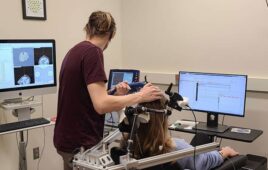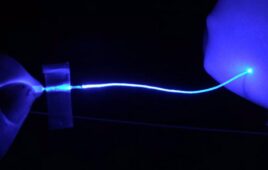Parkinson’s disease (PD) is a chronic, progressive neurological disorder affecting approximately 6 million people globally and is expected to double by 2040. PD leads to disabling motor features including tremor, reduced speed, and gait/balance impairment leading to falls, as well as non-motor symptoms such as cognitive impairment and sleep and speech disorders.
One of the most prevalent complications in PD patients is medication ON and OFF motor fluctuations, which occur in 50 percent of patients diagnosed within three to five years and 80 percent diagnosed within 10 years. The onset of these motor fluctuations is a critical point in managing the disease because it requires ongoing adjustments in treatment such as changing the frequency and dosage of medication or changing parameters for deep brain stimulation.
Currently, PD motor fluctuations are addressed with brief clinical examinations or appropriate history-taking and patient self-reports, which rely on extensive patient education. Even then, self-reports can be unreliable and clinical examinations may not be practical, especially in rural areas. Patients often require frequent follow-up visits with their neurologist.
Researchers from Florida Atlantic University’s College of Engineering and Computer Science have developed an innovative way to automatically and reliably detect and monitor medication ON and OFF states in PD patients. They have combined an algorithm and sensor-based system that detects ON and OFF state patterns in PD patients using two wearable motion sensors placed on the patient’s most affected wrist and ankle.
For the study, published in the journal Medical Engineering and Physics, these sensors collected movement signals while patients performed seven daily living activities such as walking or getting dressed in their medication ON and OFF phases. The algorithm was trained using approximately 15 percent of the data from four activities and tested on the remaining data. Data from the two sensors provided objective measures instead of a patient diary or self-report.
Results of the study reveal that the algorithm was able to detect the response to medication during the subjects’ daily routine activities with an average of 90.5 percent accuracy, 94.2 percent sensitivity, and 85.4 percent specificity.
“Our approach is novel because it is customized to each patient rather than a ‘one-size-fits-all’ approach and can continuously detect and report medication ON and OFF states as patients perform different daily routine activities,” said Behnaz Ghoraani, Ph.D., senior author, an assistant professor in FAU’s Department of Computer and Electrical Engineering and Computer Science, and a fellow of FAU’s Institute for Sensing and Embedded Network Systems (I-SENSE) and FAU’s Brain Institute (I-BRAIN), two of the university’s four research pillars. “Once the algorithm is trained, it can readily be used as a passive system to monitor medication fluctuations without relying on patient or physician engagement.”
The goal of Ghoraani and co-authors Murtadha D. Hssayeni, a Ph.D. student at FAU, Michelle A. Burack, M.D., Ph.D., University of Rochester Medical Center, and Joohi Jimenez-Shahed, M.D., Baylor College of Medicine, was to develop an individualized system that can be trained using the data collected during a patient’s first clinical visit. Patients would benefit from an automated and user-friendly system readily used to detect their response to medication on a continuous basis.
“There is a great need for a technology-based system to provide reliable and objective information about the duration in different medication phases for patients with Parkinson’s disease that can be used by the treating physician to successfully adjust therapy,” said Stella Batalama, Ph.D., dean of FAU’s College of Engineering and Computer Science. “The research that professor Ghoraani and her collaborators are doing in this field could considerably improve both the delivery of care and the quality of life for the millions of patients who are afflicted by this debilitating neurodegenerative disease.”
The sensor-based passive assessment system and algorithm combination will enable the development of an in-home monitoring system that provides comprehensive, clinically actionable information about a patient’s motor fluctuation severity and could serve as a proxy for clinical measurement that also could have applications for telehealth.




